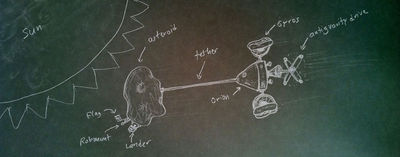Difference between revisions of "Orion"
Jump to navigation
Jump to search

Giantsquid (talk | contribs) |
|||
| Line 2: | Line 2: | ||
'''Orion''' was a manned spacecraft designed by [[NASA]] graphic artists. It was powered by tasty [[gyro]] meat, and its engine was a revolutionary anti-gravity device designed by [[Greeks]]. It was notable for employing a tether which enabled the spacecraft to rendezvous with an asteroid in order to deploy a [[Project-M|legless robot]]. | '''Orion''' was a manned spacecraft designed by [[NASA]] graphic artists. It was powered by tasty [[gyro]] meat, and its engine was a revolutionary anti-gravity device designed by [[Greeks]]. It was notable for employing a tether which enabled the spacecraft to rendezvous with an asteroid in order to deploy a [[Project-M|legless robot]]. | ||
| + | |||
| + | [[File:Dyson.jpg|300px|thumb|right|Orion Interstellar Flight Test 1: In which Orion will leave the [[Earth]]'s [[Dyson Sphere]] and journey to [[Alpha Centuari]] via [[tether]].]] | ||
The Orion 2B model also included a [[solar sail]] and a [[ham radio]]. | The Orion 2B model also included a [[solar sail]] and a [[ham radio]]. | ||
Revision as of 22:49, 12 April 2011
Orion was a manned spacecraft designed by NASA graphic artists. It was powered by tasty gyro meat, and its engine was a revolutionary anti-gravity device designed by Greeks. It was notable for employing a tether which enabled the spacecraft to rendezvous with an asteroid in order to deploy a legless robot.

Orion Interstellar Flight Test 1: In which Orion will leave the Earth's Dyson Sphere and journey to Alpha Centuari via tether.
The Orion 2B model also included a solar sail and a ham radio.
Future versions of the Orion may be ready in time to boost the orbit of the Skylab space station before its orbit decays.
